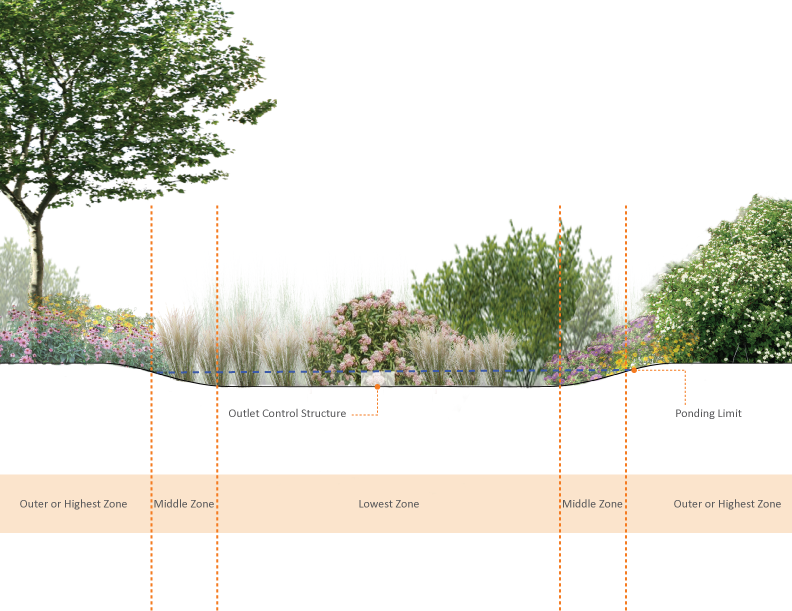4.13.1 Landscaping Introduction
Landscaping is a critical element to improve both the function and appearance of vegetated SMPs. Plants can improve the performance and lifespan of the stormwater management practice (SMP) by reducing stormwater runoff volumes and sediment load. In addition, vegetated SMPs can provide significant environmental, social, and economic benefits. Vegetation in urban environments can mitigate the urban heat island and reduce energy demands, improve air quality, provide habitat, improve human health, and increase land values. Integrated stormwater landscapes can also provide construction cost savings, reduced maintenance, and improved long-term functionality.
A successful landscape must begin with an understanding of the site. Urban environments present numerous challenges for plant survival such as increased heat, extreme weather events, pollutants, and vandalism. Additionally, SMPs bring their own set of challenges including space constraints, engineered soils, and stormwater flow. Furthermore, the landscape of a site will evolve over time, Successful landscape designs will also consider the intended site uses, preferences of the property owner and site users, and maintenance capabilities and schedules. Each site will have unique challenges and require unique solutions to ensure that the project is beautiful and functional.
As discussed in Section 3.2.7, Planting and Vegetation Guidance, vegetated SMPs are among the most preferred SMP types, and well-designed landscaping can provide many benefits to the site’s function and provided benefits. Well-designed landscapes provide longevity benefits in addition to aesthetics to a site. The designer is directed to Section 3.2.7 for more information on why these types of SMPs provide benefit. This Section provides guidance on the technical landscaping considerations for vegetated SMPs, however the designer should reference the following individual SMP Sections of Chapter 4 for SMP-specific guidance regarding vegetation:
The design of an effective landscaping may incorporate any number of these or other types of vegetation and materials, and the designer should not be limited by the guidance provided in this Manual. Successful landscape plans will combine the appropriate materials and designs specific to each site.
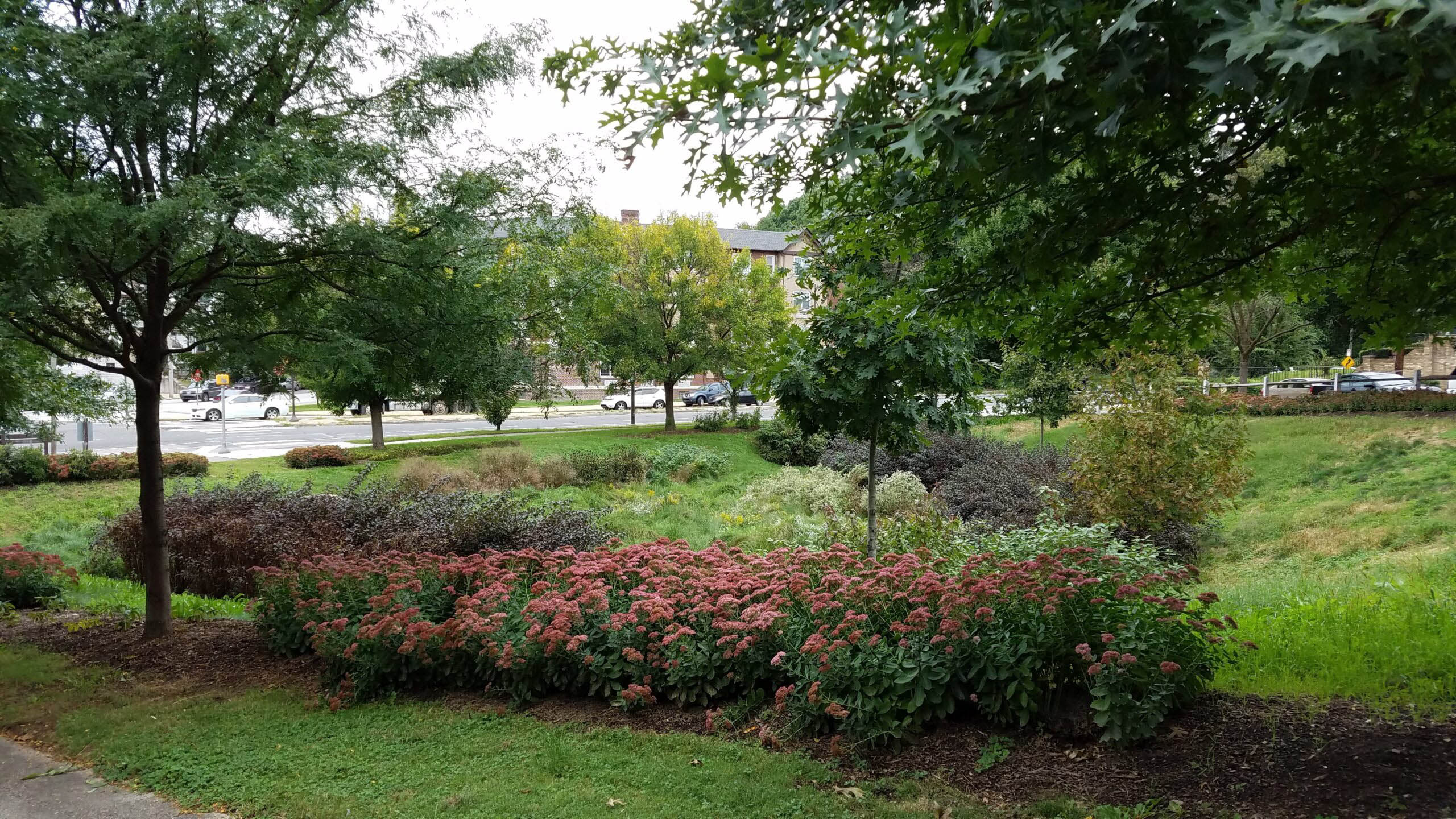
4.13.2 Landscaping Site Selection and Layout Considerations
Vegetation guidance is a critical component of many different stormwater management strategies, including structural and non-structural designs.
One method that designers can use to reduce DCIA is through disconnection of impervious areas to pervious areas. Specific guidance for disconnection strategies is provided in Section 3.1.5, Disconnection Impervious Cover. This section may assist the designer to select landscaping that considers impervious area stormwater flow.
If the designer is planning to implement vegetated SMPs on site, this chapter is intended to supplement the information provided in that SMP’s own chapter within this manual. This section should be used in conjunction with Section 4.1, Bioinfiltration/Bioretention, in most cases. It may also be a helpful reference for:
Landscaping design should be site-specific. The GSI Landscape Design Guidebook was developed by the landscape architects of the Green City, Clean Waters program to provide all designers with experienced-based content and knowledge, enabling this site-specific landscaping design for any green stormwater infrastructure SMP within the City of Philadelphia. Chapter 2 of the GSI Landscape Design Guidebook (page 14) specifically discusses Site Assessment and Landscape Design Guidelines. The following characteristics should be considered from the site analysis in developing plans for a vegetated SMP.
Site Selection
- When selecting a location for the SMP, the designer should consider the physical variables of the site and the effects they will have on the SMP. The designed is referred to pages 16 and 17 Site Conditions in the GSI Landscape Design Guidebook for further guidance on site variables.
- Some variables to consider include amount of sunlight received and solar orientation, wind speed and direction, temperature gain, and surface character. For example, sites facing northeast receive morning sun and tend to be cooler and wetter than those facing southwest. Also, runoff from asphalt will be hotter than that from concrete because asphalt’s dark color absorbs more solar energy. Combinations of these variables create different micro-climates and should be taken into account when placing the SMP and selecting plants.
Figure 4.13‑1: Micro-Climate Diagram from the GSI Landscape Design Guidebook
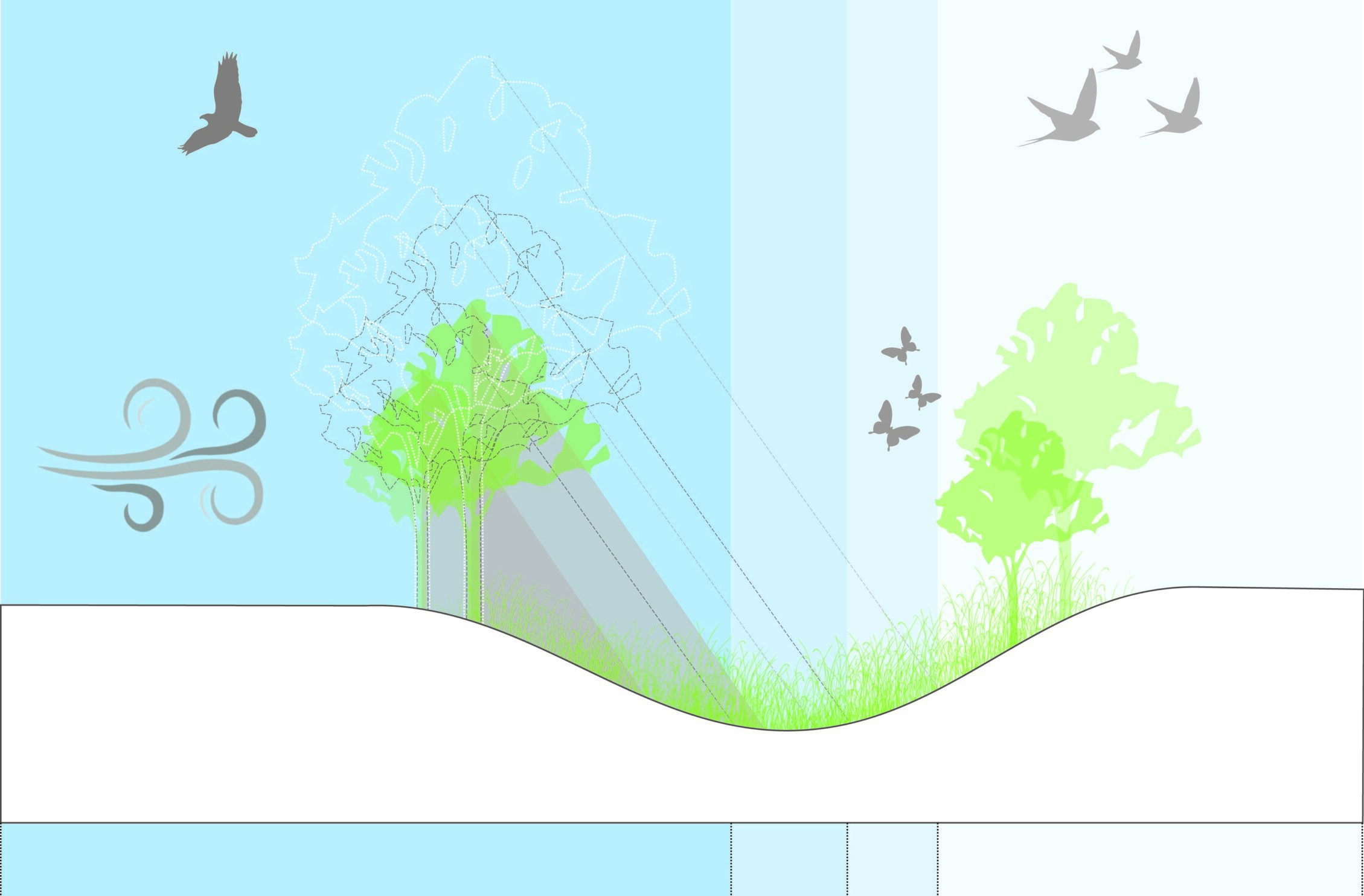
Shade Tolerance and Direct Sunlight
The light requirements for each species are listed as ranges between full shade and full sun. At the bottom of the range – full shade – plants thrive in conditions where they receive filtered, or dappled, light for the entire day (such as under an oak tree). In the middle of the range are plants that grow best in partial shade, where they are in full shade for two to three hours during midday. Plants that require full sun should be sited so that they receive five or more hours of direct sun during the growing season. Some plants requiring full sun may still do well in a partial shade environment, depending on the quality and duration of the light the plants receive when they are not in shade.
Figure 4.13‑2: Micro-Climate and Landscape Design from GSI Landscape Design Guidebook
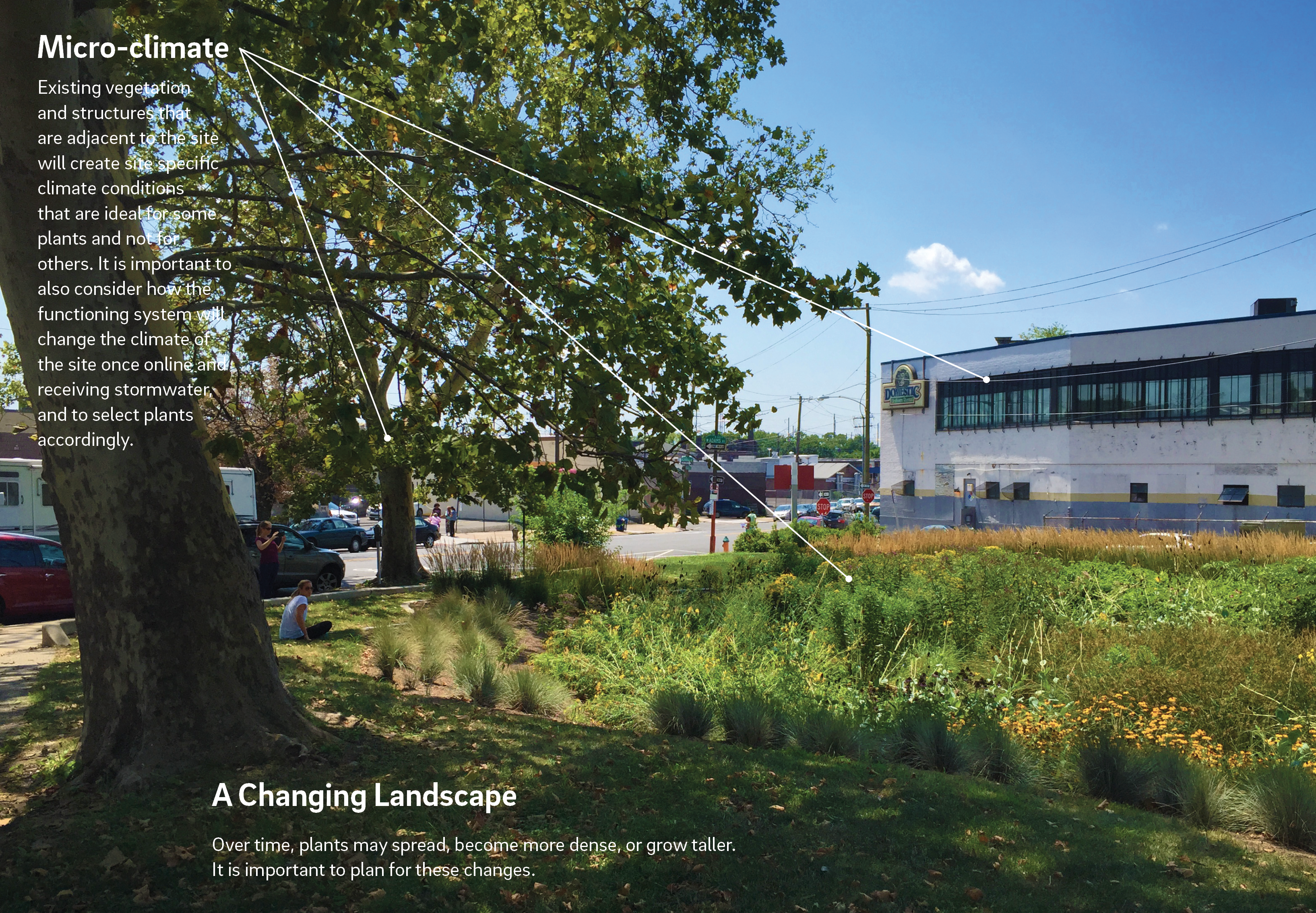
Hydrologic Zones
- For planting within a stormwater management practice (SMP), it is necessary to determine what hydrologic zones will be created within the SMP. Hydrologic zones describe the degree to which an area is inundated by water (the designer is referred to Figure 4.13‑3 for an example of hydrologic zones in a bioinfiltration/bioretention basin). Plants have differing tolerances to inundation and, as an aid to landscape designers, these plant tolerance levels have been divided into six zones and corresponding appropriate plant species have been identified. In Table I-1 of Appendix I, each plant species has a corresponding hydrologic zone provided to indicate the most suitable planting location for successful establishment. While the most common zones for planting are listed in parentheses, the listing of additional zones indicates that a plant may survive over a broad range of hydrologic conditions. Just as plants may, on occasion, be found outside of their hardiness zone, they may also be found outside of their hydrologic zone. Additionally, hydrologic conditions in an SMP may fluctuate in unpredictable ways; thus, the use of plants capable of tolerating wide varieties of hydrologic conditions greatly increases a successful planting. Conversely, plants suited for specific hydrologic conditions may perish when hydrologic conditions fluctuate, thus exposing the soil and increasing the chance for erosion.
- Table I-1, in addition to hydrologic zones, also includes drought tolerance and salt tolerance classifications. These parameters may also be used for vegetation selection for a site’s characteristics. The designer is referred to Appendix I for more information.
- The designer should also consider the entrance zone of the SMP. From page 34 of the GSI Landscape Design Guidebook, “The point where stormwater will be entering the SMP can be a difficult area for selecting plants. This zone is typically where there will be the highest velocity and volume of water entering as well as the highest concentration of sediment and pollutant loads. Therefore, selecting durable species that have strong structures and root systems is critical.”
Figure 4.13‑3: Hydrologic Zones of a Bioinfiltration/Bioretention Basin
The lowest zone (hydrologic zones 2-4) contains plant species adapted to standing and fluctuating water levels and frequent inundation. Frequently used native plants include the following species. The designer is referred to Table I-1 in Appendix I for a complete listing.
Table 4.13‑1: Frequently Used Native Plants for Hydrologic Zones 2-4
| Frequently Used Native Plants for Hydrologic Zones 2-4 | |
|---|---|
| asters (Aster spp.) | winterberry (Ilex verticillata) |
| goldenrods (Solidago spp.) | arrowwood (Viburnum dentatum) |
| bergamot (Monarda fistulosa) | sweet pepperbush (Clethra alnifolia) |
| blue-flag iris (Iris versicolor) | bayberry (Myrica pensylvanica) |
| sedges (Carex spp.) | buttonbush (Cephalanthus occidentalis) |
| ironweed (Vernonia noveboracensis) | swamp azalea (Rhododendron viscosum) |
| blue vervain (Verbena hastata) | elderberry (Sambucus canadensis) |
| joe-pye weed (Eupatorium spp.) | red maple (Acer rubrum) |
| swamp milkweed (Asclepias incarnata) | river birch (Betula nigra) |
| switchgrass (Panicum virgatum) | sweetgum (Liquidambar styraciflua) |
| shrub dogwoods (Cornus spp.) | northern white cedar (Juniperus virginiana) |
The middle zone (hydrologic zones 4-5) is slightly drier than the lowest zone, but plants should still tolerate fluctuating water levels. Frequently used native plants include the following species. The designer is referred to Table I-1 in Appendix I for a complete listing.
Table 4.13‑2: Frequently Used Native Plants for Hydrologic Zones 4-5
| Frequently Used Native Plants for Hydrologic Zones 4-5 | |
|---|---|
| black snakeroot (Cimicifuga racemosa) | spicebush (Lindera benzoin) |
| switchgrass (Panicum virgatum) | hackberry (Celtis occidentalis) |
| spotted joe-pye weed (Eupatorium maculatum) | willow oak (Quercus phellos) |
| cutleaf coneflower (Rudabeckia lacinata) | winterberry (Ilex verticillata) |
| frosted hawthorn (Crataegus pruinosa) | slippery elm (Ulmus rubra) |
| marginal wood fern (Dryopteris marginalis) | viburnums (Viburnum spp.) |
| ironwood (Carpinus caroliniana) | witch-hazel (Hamamelis virginiana) |
| serviceberry (Amelanchier canadensis) | steeplebush (Spiraea tomentosa) |
| obedient plant (Physostegia virginiana) | blueberry (Vaccinium spp.) |
The outer zone (hydrologic zones 5-6) generally supports plants adapted to drier conditions. Frequently used native plants include the following species. The designer is referred to Table I-1 in Appendix I for a complete listing.
Table 4.13‑3: Frequently Used Native Plants for Hydrologic Zones 5-6
| Frequently Used Native Plants for Hydrologic Zones 5-6 | |
|---|---|
| herbaceous plants | juniper (Juniperus communis) |
| basswood (Tilia americana) | sweet-fern (Comptonia peregrina) |
| white oak (Quercus alba) | eastern red cedar (Juniperus virginiana) |
| scarlet oak (Quercus coccinea) | smooth serviceberry (Amelanchier laevis) |
| black oak (Quercus velutina) | american holly (Ilex opaca) |
| american beech (Fagus grandifolia) | sassafras (Sassafras albidum) |
| black chokeberry (Aronia melanocarpa) | white pine (Pinus strobus) |
Screening and Aesthetics
- Some SMP elements such as chain link fences, concrete bulkheads, outfalls, riprap, berm embankments planted only with grasses, exposed pipe, banks, retaining walls greater than two feet high, and access roads are generally not aesthetically pleasing. When these elements face public right-of-way or other private property, these elements should be screened with plant materials.
- The designer is strongly encouraged to integrate aesthetically pleasing landscape design into SMP design.
4.13.3 Landscaping Design Considerations
The planting recommendations within this Section are informed by research, local experience, and/or standard landscape industry methods for design and construction.
General Planting Design Guidance
- Selected plant materials must be appropriate for soil, hydrologic, and other site conditions.
- Vegetated SMPs must use appropriate native and recommended non-invasive species from Appendix I.
- The design for planting should minimize the need for herbicides, fertilizers, pesticides, or soil amendments at any time before, during, and after construction and on a long-term basis.
- Plantings should be designed to minimize the need for mowing, pruning, and irrigation.
- Seed must be applied at the rates specified by the suppliers. If plant establishment cannot be achieved with seeding by the time of substantial completion of the SMP portion of the project, the contractor must plant the area with sod, plugs, container plants, or some other means to complete the specified plantings and protect against erosion.
- The designer may recommend a diversity of tree species and avoid overused species to reduce the risk of disease or insect infestation.
- The designer should avoid combinations of plants that will harm one another. For example, a designer should not plant junipers next to rust-susceptible plants like crabapples.
- The designer should consider the mature size of any plant and ensure that it has enough space to grow to this size. The designer should also consider critical lines for sight for vehicular or pedestrian traffic.
- It is essential that impervious surfaces be graded toward the vegetated areas that are used as SMPs, and that these SMPs are depressed to allow for flow and/or surface ponding.
Quantity and Spacing
Spacing of plant containers can depend on the plants’ characteristics. Smaller containers and plant varieties may require tighter spacing than larger containers or larger mature growth. The designer is referred to the GSI Landscape Design Guidebook (page 19) for more assistance. Generally, six-inch to twelve-inch centers with triangular spacings for plugs are recommended.
Figure 4.13‑4: Recommended Plant Spacing
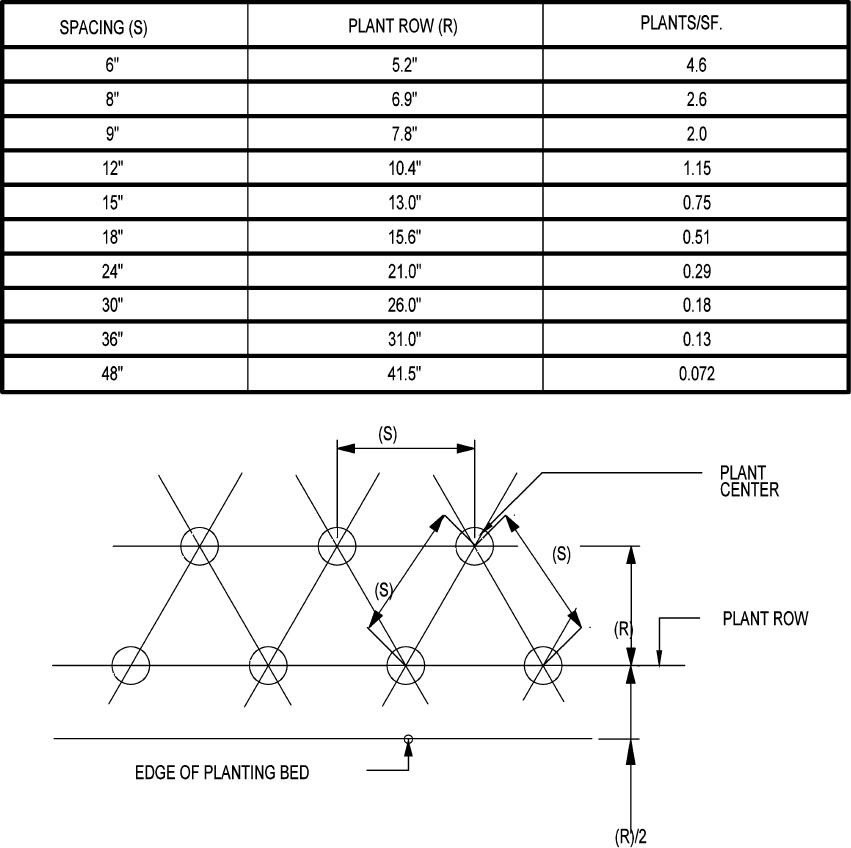
Mature Canopy Spread
The “Mature Canopy Spread” column of Table I-1 in Appendix I gives the SMP designer a rough estimate of the diameter (or spread) of a tree species’ branching when it has matured. This information indicates what the light conditions will be like beneath the tree for understory plantings; how much space should be left open between the tree planting pit and any vertical structures, such as buildings; how far apart the trees should be planted; and it gives an idea, along with the mature height of the species, of the tree’s growth habit. The mature canopy spread also provides a rough idea for how much leaf surface area will be available to intercept stormwater before it reaches the ground.
Species Selection and Arrangement
- Existing native and non-native adapted vegetation should be preserved where possible.
- Noxious and invasive weeds must not be specified or used. The designer is referred to Table I-2 in Appendix I for a list of species to avoid. Aggressive species should be used carefully to avoid spreading to other areas.
- Stream and water buffers should be planted with trees, shrubs, ornamental grasses, and herbaceous materials, where possible, to stabilize banks and provide shade. This will help to reduce thermal warming, reduce erosion, increase roughness, and protect habitat.
- Plantings that will require routine or intensive chemical applications (e.g., turf areas) should be avoided. Low-maintenance ground cover should be used as an alternative to turf.
- The designer should consider possible stressors (e.g., wind, exposure, exposure to runoff pollutants such as deicing salt, salt tolerance, insects, drought and inundation tolerance, and disease), micro-climates, and sunlight conditions when laying out the planting plan.
- Aesthetics and visual characteristics should be a prime consideration when developing planting plans. Plant form, texture, color, bloom time, and fragrance are important to the overall feel of the site. Plants can be used to enhance and frame desirable views or screen undesirable views. Care should be taken to not block views at entrances, exits, or along difficult road curves.
- The time of year when the site will be most active should be considered to decide which season to emphasize most prominently. The designer may use flowering perennials as accents that will bloom throughout the growing season and includes shrubs with interesting winter structure to showcase during the dormant season. Some characteristics the designer should keep in mind are evergreen needles, fall foliage color, seasonal fruits and flowers, bark texture, and leaf color. The designer is referred to the GSI Landscape Design Guidebook for more information.
- Where such conditions exist, trees and shrubs should be placed in a manner that restricts pedestrian access to steep pools or slopes without blocking maintenance access.
- Existing and proposed utilities must be identified and considered.
- Other considerations for designers for plant selection and arrangement are planting in massings, an appropriate number of species, enhancing habitat, defining an edge, plant height, site lines, and other site contexts. The designer is referred to pages 20 through 27 of the GSI Landscape Design Guidebook for more information.
Figure 4.13‑5: Plant Seasonality from the GSI Landscape Design Guidebook
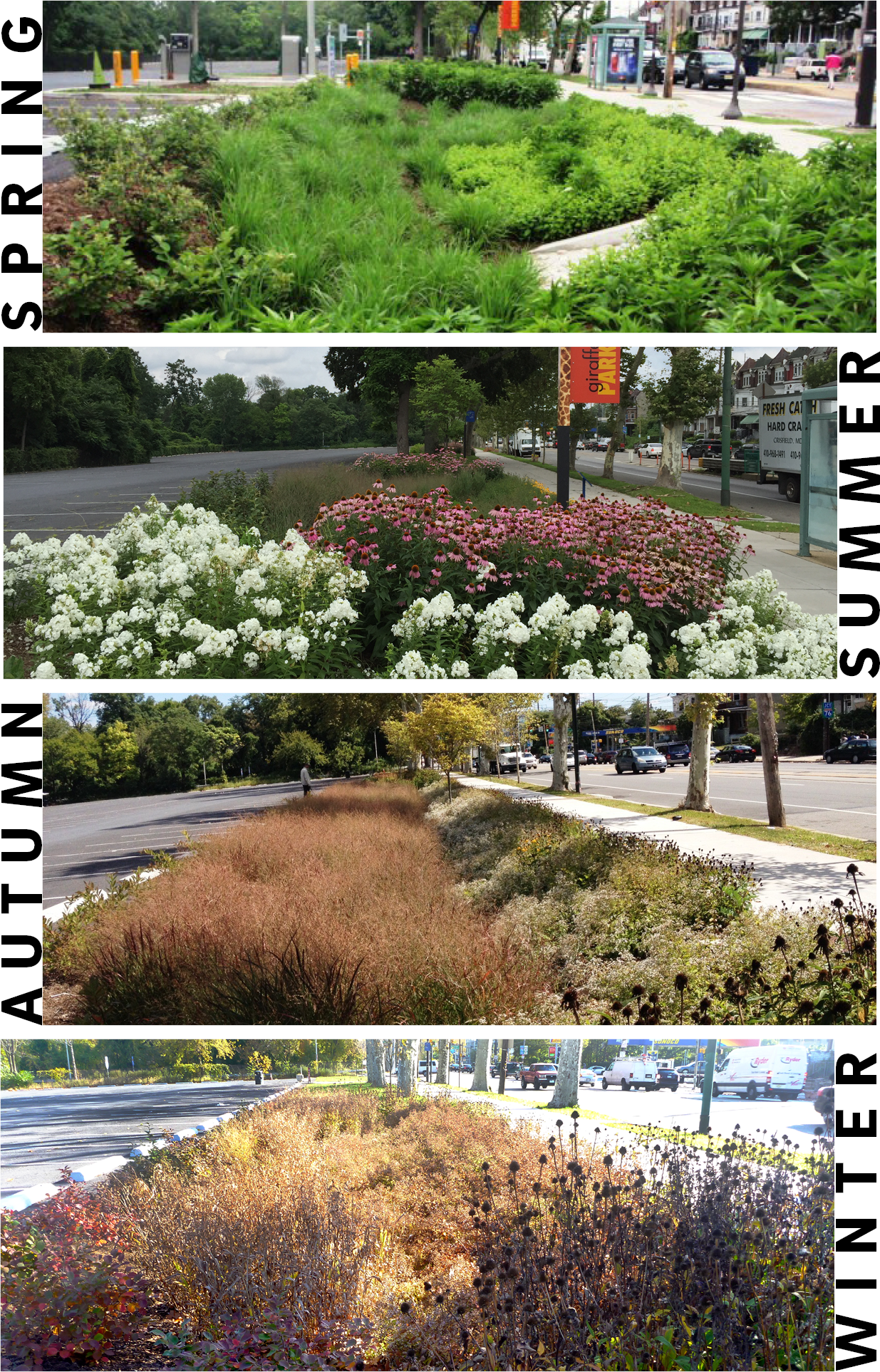
Plant Nativity
- A native plant is any indigenous species that subsisted in the region prior to settlement by the Europeans. Each species within the “Nativity” column of Table I-1 in Appendix I is located within a range of nativity to Philadelphia. Plants known to have existed in Philadelphia County are native to Philadelphia, while a wider geographic range lists plants native to the state, but not necessarily to the county. The widest geographic range lists a few species native to the United States, but not necessarily to Pennsylvania. The plants listed that are not specifically native to Philadelphia are included because of their demonstrated success within SMPs.
- Invasive plants reproduce rapidly, degrade, and take over natural ecosystems. Under no circumstance should they be planted in a SMP. Because of appealing characteristics, some of these plants are available for sale, and care should be taken not to purchase them. Additionally, the ability to identify and remove them before they can establish themselves is important, as they almost always invade due to their gregarious reproductive strategies. They can be especially hard to eradicate once they take hold. The designer is referred to Table I-2 in Appendix I for a list of species to avoid.
Embankments, Spillways, and Dams
- Planting of trees, shrubs, and/or any type of woody vegetation is not allowed on structural embankments.
- All emergency spillways should be stabilized with plant material that can withstand strong flows. Root material should be fibrous and substantial but lack a taproot.
- Trees or shrubs known to have long taproots should not be planted within the vicinity of an earthen dam or subsurface drainage facilities.
- Trees and shrubs should be planted at least 25 feet away from a principal spillway structure and at least 15 feet away from a dam’s toe of slope.
Mulch and Soil Media
- The mulch layer helps maintain soil moisture and avoid surface sealing that reduces permeability. Mulch helps prevent erosion and provides a micro-environment suitable for soil biota at the mulch/soil interface. It also serves as a pretreatment layer, trapping the finer sediments that remain suspended after the primary pretreatment.
- For herbaceous plantings, mulch must be applied to cover all soil between plants.
- Care should be exercised to use the appropriate amount of mulch – any more than three to four inches can negatively impact growing conditions and cause excessive nutrients to leach into the SMP.
- Mulch must be weed-free. Manure mulching and high-fertilizer hydroseeding are prohibited in a SMP area during and after construction.
- Mulch should be kept three inches away from tree trunks, woody vegetation, and the base of herbaceous vegetation.
- Permanent irrigation systems are allowed, but the designer is encouraged to minimize the need for permanent irrigation. Innovative methods for watering vegetation are encouraged, such as the use of cisterns and air conditioning condensate.
- To ensure landscape plant survival and overall stormwater facility functional success, the design and construction documents must include elements that help achieve these results.
- The characteristics of the soil for the bioinfiltration/bioretention SMP are perhaps as important as the facility location, size, and treatment volume. The soil must be permeable enough to allow runoff to filter through the media, while having characteristics suitable to promote and sustain a robust vegetative cover crop. In addition, much of the nutrient pollutant uptake (nitrogen and phosphorus) is accomplished through adsorption and microbial activity within the soil profile. Therefore, the soils must balance soil chemistry and physical properties to support biotic communities above and below ground.
4.13.4 Landscaping Material Standards
Landscaping relies on informed design and material standards for successful landscapes. Designers should consider the following material guidance for selecting and sourcing materials for the site.
Storage Area Material Standards
- Stone designed for stormwater storage must be uniformly graded, crushed, clean-washed stone. PWD defines “clean-washed” as having less than 0.5% wash loss, by mass, when tested per American Association of State Highway and Transportation Officials (AASHTO) T-11 wash loss test. AASHTO No. 3 and No. 57 stone can meet this specification.
- Sand, if used, must be AASHTO M-6 or American Society of Testing and Materials (ASTM) C-33 sand and must have a grain size of 0.02 to 0.04 inches.
- Planting Soil Medium
- Planting soil should meet all the specifications listed below and should be a fertile, natural soil, free from large stones, roots, sticks, clods, plants, peat, sod, pockets of coarse sand, pavement and building debris, glass, noxious weeds including invasive species, infestations of undesirable organisms and disease-causing pathogens, and other extraneous materials harmful to plant growth.
- The texture of planting soil should conform to the classification within the United States Department of Agriculture triangle for Sandy Loam or Loamy Sand. Planting soil should be a mixture of sand, silt, and clay particles as required to meet the classification. Ranges of particle size distribution, as determined by pipette method in compliance with ASTM F-1632, are as follows:
- Sand (0.05 to 2.0 mm): 50 – 85%
- Silt (0.002 to 0.05mm): 40% maximum
- Clay (less than 0.002mm): 10% maximum
- Gravel (2.0 to 12.7 mm): 15% maximum
- Planting soil should be screened and free of stones larger than a half-inch (12.7 millimeters) in any dimension. No more than 10% of the soil volume should be composed of soil peds greater than one inch.
- Clods, or natural clumps of soils, greater than three inches in any dimension should be absent from the planting soil. Small clods ranging from one to three inches and peds, natural soil clumps under one inch in any dimension, may be present but should not make up more than 10% of the soil by volume.
- The pH of the planting soil should have a range of 5.8 to 7.1.
- Soluble salts should be less than 2.0 mmhos/cm (dS/m), typically as measured by 1:2 soil-water ratio basic soil salinity testing. Sodic soils (Exchangeable Sodium Percentage greater than 15 and/or Sodium Adsorption Ratio greater than 13) are not acceptable for use regardless of amendment.
- Organic content of planting soil should have a range of 3% to 15% by weight, as determined by loss on ignition (ASTM D2974). To adjust organic content, planting soil may be amended, prior to placing and final grading, with the addition of organic compost.
- Mulch, if used, must be free of weeds and must consist of aged, double-shredded hardwood bark mulch or leaf mulch that has been shredded sufficiently to limit risk of matting, which can limit surface infiltration rates. For hydroseeding, paper mulch may be used. Approved mulching materials include organic materials such as compost, bark mulch, leaves, as well as small river gravel, pumice, or other inert materials. Grass clippings should not be used as mulch.
- Geotextile must consist of polypropylene fibers and meet the following specifications (AASHTO Class 1 or Class 2 geotextile is recommended):
- Grab Tensile Strength (ASTM-D4632): ≥ 120 lbs
- Mullen Burst Strength (ASTM-D3786): ≥ 225 psi
- Flow Rate (ASTM-D4491): ≥ 95 gal/min/ft2
- UV Resistance after 500 hours (ASTM-D4355): ≥ 70%
- Heat-set or heat-calendared fabrics are not permitted
Vegetation Material Standards
- Trees and shrubs must be freshly dug and grown in accordance with good nursery practice.
- Perennials and herbaceous plants must be healthy, well-rooted specimens.
- A native grass/wildflower seed mix can be used as an alternative to groundcover planting. Seed mix must be free of weed seeds.
- Use of invasive plants is not permitted. All plants and trees must be appropriate and compatible with soil, hydrologic, light, and other site conditions. The designer is referred to Appendix I for plant lists.
- SMP soils should provide adequate infiltration rates and be suitable for healthy tree and vegetation growth. Soil analysis must be conducted within the SMP area to determine appropriate levels and types of soil amendments. The designer is referred to Section 3.3.6, Evaluation of Infiltration Testing Results, for additional guidance and requirements for soil amendment installation.
- If topsoil exists on-site and is stockpiled for re-use, appropriate erosion control measures, as required by the latest edition of the PA DEP Erosion and Sediment Pollution Control Program Manual, must be used.
4.13.5 Landscaping Construction Guidance
Careful consideration of issues like soil compaction, infiltration performance, and sediment control are critical to ensure proper vegetated SMP functionality and reduce long-term maintenance needs. Poor oversight of construction activities could result in the need for substantial reconstruction to address performance problems.
General Landscaping Sequence
- Provide erosion and sedimentation control protection on the site such that construction runoff is directed away from the proposed vegetated SMP location. The designer is referred to the latest edition of the PA DEP Erosion and Sediment Pollution Control Program Manual for information on design standards for erosion and sedimentation control practices.
- Critical areas, including vegetated SMPs, must be physically marked prior to any land-disturbing activities to avoid soil disturbance and compaction during construction. Install construction fencing around these critical areas.
- After allowing for settlement, complete final grading within about two inches of the proposed design elevations, leaving space for top dressing of mulch or mulch/compost blend.
- Seed and plant vegetation as indicated on the plans and specifications.
- Place mulch and hand grade to final elevations.
- Water vegetation at the end of each day for two weeks after planting is completed.
- Water vegetation regularly during first year to ensure successful establishment.
Establishment and Stabilization
- Establishment procedures must include: control of invasive weeds, prevention of damage from animals and vandals, use of erosion control mats and fabrics in channels, temporary diversion of flows from seeded areas until stabilized, mulching, re-staking, watering, and mesh or tube protection replacement, to the extent needed to ensure plant survival.
- Generally, there are two planting seasons in a calendar year; Spring begins in March and ends in May, and Fall begins in September and ends in November, but planting is temperature dependent and varies year to year.
- Unwanted vegetation in the SMP area should be removed during site preparation with equipment appropriate for the type of material encountered, and site conditions. It is recommended that the maximum amount of pre-existing native vegetation be retained and protected.
- No material storage or heavy equipment is allowed within the SMP area after site clearing and grading has been completed, except to excavate and grade, as needed, to build the SMP. No compaction of infiltration areas must occur during this excavation.
- After the SMP area is cleared and graded, any necessary soil amendments should be added and tilled into the existing soil to the depth specified for each SMP. No tilling should occur within the drip line of existing trees. After tilling is complete, no other construction traffic must be allowed in the area, except for planting and related work. Where topsoil is needed, it should be spread to a depth of four to eight inches and lightly compacted to minimum thickness of four inches. This provides organic matter and important nutrients for the plant material. The use of topsoil allows vegetation to become established faster and roots to penetrate deeper. This ensures quicker and more complete stabilization, making it less likely that the plants will wash out during a heavy storm.
- Newly installed plant material requires water in order to recover from the shock of being transplanted. A source of water should be provided during establishment of the SMP, especially during dry periods. This will reduce plant loss and provide the new plant materials with a chance to establish root growth.
- Establishment procedures must be applied temporarily (typically ranges from 8-weeks to 2-years). These measures include: control of invasive weeds, prevention of damage from animals and vandals, use of erosion control mats and fabrics in channels, temporary diversion of flows from seeded areas until stabilized, mulching, re-staking, watering, and mesh or tube protection replacement, to the extent needed to ensure plant survival.
- To ensure landscape plant survival and overall stormwater facility functional success, the design and construction documents must include elements that help achieve these results.
- Construction specifications and details must include staking, irrigation schedule, soil amendments, plant protection, overplanting, and potentially, mycorrhizal inoculation.
Table 4.13‑4 Planting Construction Specifications
| Specification Element | Elements |
|---|---|
| Sequence of Construction | Describe site preparation activities, soil amendments, etc.; address erosion and sediment control procedures; specify step-by-step procedure for plant installation through site clean-up. |
| Contractor’s Responsibilities | Specify the contractors responsibilities, such as watering, care of plant material during transport, timeliness of installation, repairs due to vandalism, etc. |
| Planting Schedule and Specifications | Specify the materials to be installed, the type of materials (e.g., B&B, bare root, containerized); time of year of installations, sequence of installation of types of plants; fertilization, stabilization seeding, if required; watering and general care. |
| Maintenance | Specify inspection periods; mulching frequency (annual mulching is most common); removal and replacement of dead and diseased vegetation; treatment of diseased trees; watering amount and schedule after initial installation (once per day for 14 days is common); repair and replacement of staking and wires. |
| Warranty | All systems should contain a two-year warranty. Specifications should contain the warranty period, the required survival rate, and expected condition of plant species at the end of the warranty period. |
4.13.6 Landscaping Maintenance Guidance
Vegetation maintenance is design-specific with the plants, grading, SMP layout, as well as external factors all influencing the types and frequencies of activities required to keep vegetated SMP functioning properly. The designer should consider maintenance when evaluating the different variables associated with landscape design. The designer is referred to pages 30 and 31 of the GSI Landscape Design Guidebook for landscaping recommendations, in addition to the below guidance.
Maintenance Considerations
- The designer should carefully consider the long-term vegetation management strategy for the SMP, keeping in mind the maintenance legacy for the future owners. The O&M Agreement will include requirements to ensure vegetation cover in perpetuity.
- When appropriate, the designer should provide signage to help educate the public about SMPs and designate limits of mowing (wildflower areas, meadows, etc.).
- The edge of the basin may be designated by woody vegetation to further designate limits of mowing and foot traffic.
- Planting in massings (each group consisting of one to three individuals of the same species) may support maintenance efforts by simplifying plant identification.
Maintenance Activities
General recommended maintenance activities for landscaped areas are summarized in Table 4.13‑5 below. More comprehensive maintenance guidance, including means and methods of various landscaping related maintenance activities including weeding, mowing, mulching, watering, and pest and disease management, are available in the GSI Maintenance Manual.
Table 4.13‑5: Landscaping Maintenance Guidelines
| Early Maintenance Activity | Frequency |
|---|---|
| Water vegetation at the end of each day for two weeks after planting is completed. | Daily for two weeks after installation |
| Water vegetation regularly to ensure successful establishment. | Every four days during periods of four or more days without rain, June through August for the first year after installation |
| Inspect vegetation for signs of disease or distress. | Biweekly for the first year after installation |
| Inspect inlet controls, outlet structures, and storage areas for trash and sediment accumulation. | Monthly for the first year after installation to determine ongoing maintenance frequency |
| Ongoing Maintenance Activity | Frequency |
|---|---|
| Remulch void areas | As Needed |
| Treat diseased trees and shrubs | As Needed |
| Keep overflow free and clear of leaves | As Needed |
| Inspect soil and repair eroded areas | Monthly |
| Remove litter and debris | Monthly |
| Clear leaves and debris from overflow | Monthly |
| Inspect trees and shrubs to evaluate health, replacing if necessary | Quarterly |
| Inspect underdrain cleanouts | Quarterly |
| Add additional mulch | Quarterly |
| Inspect for sediment build-up, erosion, and vegetative conditions. | Quarterly |
| Evaluate the drain down time of the SMP after a storm of at least one inch in no more than 24-hours to ensure an SMP drain down time of less than 72 hours. | Ongoing |
| Maintain records of all inspections and maintenance activity | Ongoing |
The designer is referred to Section 4.1, Bioinfiltration/Bioretention, Section 4.3, Green Roofs, Section 4.7, Ponds and Wet Basins, Section 4.9, Media Filters, Section 4.10, Pretreatment, Section 4.11, Inlet Controls, and Section 4.12, Outlet Controls for information on maintenance guidance for specific SMP types, pretreatment, inlet controls, outlet controls.
